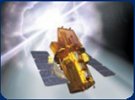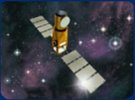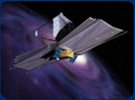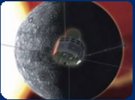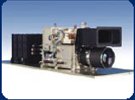Conference Information
Spacewire
SpaceWire is a leading onboard data-handling network for use onboard spacecraft. It is simple to implement and use, and is being deployed on many space missions.
Aims / Scope of Conference
The International SpaceWire Conference aims to bring together SpaceWire product designers, hardware engineers, software engineers, system developers and mission specialists interested in and working with SpaceWire to share the latest ideas and developments related to SpaceWire technology. The conference is targeted at the full SpaceWire community including both academics and industrialists.
Conference Location
The 2011 International SpaceWire Conference will be held at the Marriott Plaza Hotel in San Antonio, Texas, USA.
Technical Programme
Sessions are dedicated to the following topics:
- SpaceWire missions and applications, which covers missions using SpaceWire, how SpaceWire has been used on existing or planned spacecraft and other applications of SpaceWire.
- SpaceWire components which covers devices supporting the SpaceWire Standard such as sensor devices, electronic components, ASICs & FPGAs, cables and connectors.
- SpaceWire onboard equipment and software, which covers products supporting the SpaceWire Standard including onboard equipment, instruments and related onboard software.
- SpaceWire test and verification, which covers the test and verification of SpaceWire components, equipment and systems including FPGA/ASIC validation techniques, cable/connector testing and approaches to system level test.
- SpaceWire networks and protocols, which covers network architectures, configuration, discovery and "plug and play" concepts, higher-level protocols for SpaceWire and related software designs and issues.
- SpaceWire standardisation, which covers the SpaceWire Standard, new protocols being prepared for standardisation and candidates for future standardisation.
Registration
Click here to view registration information
Keynote Speakers
Mr. BRET G. DRAKE; Deputy Chief Architect, Human Spaceflight Architecture Team, Exploration Missions and Systems Office, NASA Johnson Space Center
Technical Committee
- Allison Bertrand, South West Research Institute, USA
- Barry Cook - 4 Links Ltd., UK
- Stephane Davy – Syderal, Switzerland
- Omar Emam - Astrium, UK
- Wahida Gasti - ESA, The Netherlands
- Daniel Gilley - Lockheed Martin, USA
- Alain Girard - Thales Alenia Space, France
- Viacheslav Grishin- Submicron PLC, Russia
- Sev Gunes-Lasnet - Astrium, France
- Omar Haddad - Dell, USA
- Hiroki Hihara - NEC, Japan
- Christophe Honvault - ESA
- Torbjorn Hult - RUAG Space, Sweden
- Jørgen Ilstad - ESA, The Netherlands
- Paul Jaffe - Naval Research Laboratory, USA
- David Jameux- ESA, The Netherlands
- Gerald Kempf - RUAG Space, Austria
- Clifford Kimmery - Honeywell Inc., USA
- Alexander Kisin - MEI, USA
- Robert Klar - South West Research Institute, USA
- Jim Lux - NASA JPL, USA
- Patrick McGuirk - PnP Innovations, USA
- Peter Mendham - Scisys Ltd., UK
- Masaharu Nomachi - University of Osaka, Japan
- Olivier Notebaert - Astrium SAS, France
- Steve Parkes - University of Dundee, Scotland, UK
- Manuel Prieto - Alcala University, Spain
- Glenn Rakow - NASA GSFC, USA
- Paul Rastetter - Astrium GmbH, Germany
- Derek Schierlmann - Naval Research Laboratory, USA
- Alan Senior - SEA, UK
- Yuriy Sheynin - St. Petersburg State University of Aerospace Instrumentation, Russia
- Tatiana Solokhina - ELVEES, Russia
- Martin Suess - ESA, The Netherlands
- Tadayuki Takahashi - JAXA, Japan
- Raffaele Vitulli - ESA, The Netherlands
- Takahiro Yamada - JAXA/ISAS, Japan
Sponsors
The sponsors of the 2011 International SpaceWire Conference are:
Southwest Research Institute
 - Benefiting government, industry and the public through innovative science and technology
- Benefiting government, industry and the public through innovative science and technology
Southwest Research Institute® (SwRI®), headquartered in San Antonio, Texas, is one of the oldest and largest independent, nonprofit, applied research and development organizations in the United States. SwRI's 11 technical divisions offer a wide range of technical expertise and services in such areas as chemistry, space science, nondestructive evaluation, automation, engine design, mechanical engineering, electronics and more.
European Space Agency
 - The European Space Agency is Europe's gateway to space. Its mission is to shape the
development of Europe's space capability and ensure that investment in space continues to
deliver benefits to the citizens of Europe. ESA drove and funded the development of the
SpaceWire standard. ESA is using SpaceWire on several missions including Bepi Colombo,
GAIA and Earth Care.
- The European Space Agency is Europe's gateway to space. Its mission is to shape the
development of Europe's space capability and ensure that investment in space continues to
deliver benefits to the citizens of Europe. ESA drove and funded the development of the
SpaceWire standard. ESA is using SpaceWire on several missions including Bepi Colombo,
GAIA and Earth Care.
NASA
 - The National Aeronautics and Space Administration of the United States of America.
NASA's mission is to pioneer the future in space exploration, scientific discovery, and aeronautics research. SpaceWire is being designed into the James Webb Space Telescope, Lunar Reconnaissance Orbiter, GEOS-R and other missions, and is currently in orbit in the SWIFT spacecraft.
- The National Aeronautics and Space Administration of the United States of America.
NASA's mission is to pioneer the future in space exploration, scientific discovery, and aeronautics research. SpaceWire is being designed into the James Webb Space Telescope, Lunar Reconnaissance Orbiter, GEOS-R and other missions, and is currently in orbit in the SWIFT spacecraft.
JAXA
 - Japanese Aerospace eXploration Agency is Japan's core organization for aerospace
technology, which promotes consistent activities, from basic research to technology development
and utilization. JAXA aims to pursue the enormous possibilities in space and aviation,
and challenge various research and development fields in the aim of "Sustainable Development"
in order to contribute to peace and happiness for all mankind. JAXA is using SpaceWire on
the Mercury Magnetospheric Orbiter and NeXT.
- Japanese Aerospace eXploration Agency is Japan's core organization for aerospace
technology, which promotes consistent activities, from basic research to technology development
and utilization. JAXA aims to pursue the enormous possibilities in space and aviation,
and challenge various research and development fields in the aim of "Sustainable Development"
in order to contribute to peace and happiness for all mankind. JAXA is using SpaceWire on
the Mercury Magnetospheric Orbiter and NeXT.
Space Technology Centre
 - Space Technology Centre, University of Dundee - A world leading centre for the development
of SpaceWire technology. The SpaceWire standard was written by University of Dundee
with input from spacecraft engineers across Europe. SpaceWire intellectual property, chips
and software being used for several international space missions was developed in the
Space Technology Centre. STAR-Dundee (www.star-dundee.com) is a
spin-out from the Space Technology Centre.
- Space Technology Centre, University of Dundee - A world leading centre for the development
of SpaceWire technology. The SpaceWire standard was written by University of Dundee
with input from spacecraft engineers across Europe. SpaceWire intellectual property, chips
and software being used for several international space missions was developed in the
Space Technology Centre. STAR-Dundee (www.star-dundee.com) is a
spin-out from the Space Technology Centre.
IEEE
 - The Institute of Electrical and Electronic Engineers is the world's leading professional
association for the advancement of technology. It is a leading authority on areas ranging
from aerospace systems, computers and telecommunications to biomedical engineering,
electric power and consumer electronics.
- The Institute of Electrical and Electronic Engineers is the world's leading professional
association for the advancement of technology. It is a leading authority on areas ranging
from aerospace systems, computers and telecommunications to biomedical engineering,
electric power and consumer electronics.
AESS
 - The Aerospace and Electronic Systems Society (AESS) offers to its members the extraordinary opportunity to become deeply connected with the three pillars of the Aerospace, Electronic and Defence sector: Industry, Institutions and Research Centers.
The effective interaction between those pillars is the key element for the organization, design, development and operation of successful Complex Systems, which are the core of the AESS Field of Interest.
- The Aerospace and Electronic Systems Society (AESS) offers to its members the extraordinary opportunity to become deeply connected with the three pillars of the Aerospace, Electronic and Defence sector: Industry, Institutions and Research Centers.
The effective interaction between those pillars is the key element for the organization, design, development and operation of successful Complex Systems, which are the core of the AESS Field of Interest.
